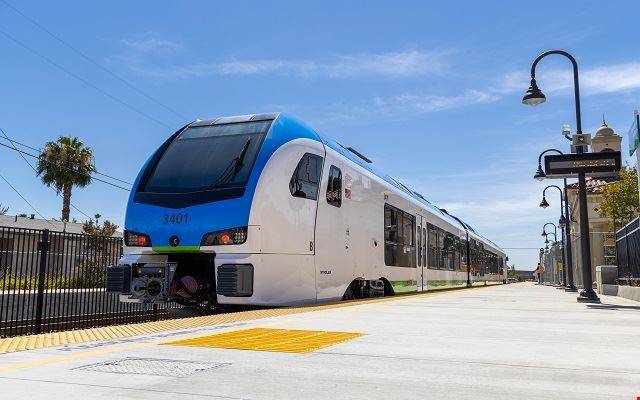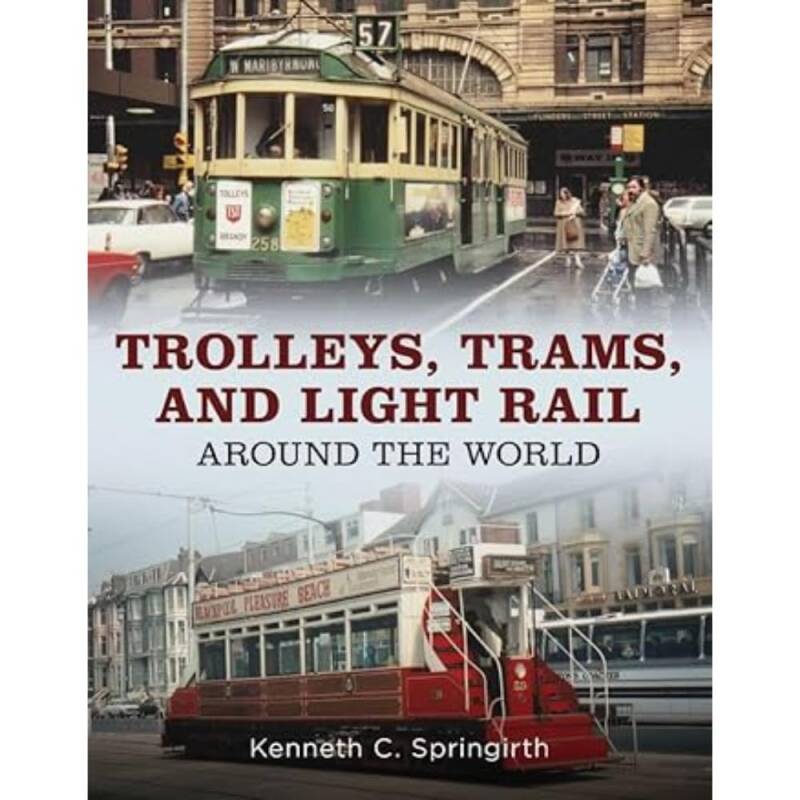
RABe 522 of the Swiss Federal Railways at Basel SBB
(NAC, CC BY-SA 3.0 <https://creativecommons.org/licenses/by-sa/3.0>, via Wikimedia Commons)

STADLER FLIRT
Stadler FLIRT (Fast Light Intercity and Regional Train; German: Flinker Leichter Intercity- und Regional-Triebzug) is a passenger multiple unit trainset made by Stadler Rail of Switzerland. The baseline design of FLIRT is an electric multiple unit articulated trainset that can come in units of two to twelve cars with two to six motorized axles. The maximum speed is 200 km/h (125 mph). Standard floor height is 57 cm (22+7⁄16 in), but 78 cm (30+11⁄16 in) high floors are also available for platform heights of 76 cm (29+15⁄16 in).
The FLIRT train was originally developed for the Swiss Federal Railways and was first delivered in 2004. The trains quickly became a success and were ordered by operators in Algeria, Azerbaijan, Belarus, Canada, the Czech Republic, Estonia, Finland, Germany, Hungary, Italy, Lithuania, the Netherlands, Norway, Poland, Serbia, Slovenia, Sweden, Switzerland, the United Kingdom, and the United States. As of October 2021, more than 2500 units have been sold.
Aside from being electric (EMU), the FLIRT is available in diesel-electric (DEMU), battery-electric, bi-mode EDMU, tri-mode diesel/overhead electric/battery, and more recently hydrogen fuel cell versions. Bi-mode models were first ordered by Italy's Aosta Valley region as (BTR.813), then by Greater Anglia as the British Rail Class 755, and Norske Tog. Tri-mode versions were first ordered by Wales & Borders. Hydrogen fuel-cell versions were first ordered by Arrow in San Bernardino County, California, USA.
"PowerPack" car of a diesel Flirt with open compartment of diesel-generator.
(M4ys3R, PDM-owner, via Wikimedia Commons)
Specifications
The FLIRT is a new generation of multiple units, even though the first versions resembles GTW vehicles. The trains can have two to six sections and electric variants are available for all commonly used power supply systems (AC and DC) as well as standard and broad gauge. It has Jacobs bogies (trucks) shared between the individual coaches, with wide walk-through gangways. The floor height at the entrances can be chosen by the operator, providing level boarding at most stations. Automatic couplers of either Schwab type (on all Swiss units) or Scharfenberg type at both ends of the train allow up to four trains to be connected.
All FLIRT variations use IGBT-based traction converters from ABB, which drive the TSA induction motors located in the two bogies at either end of the train. On the two-section trains, only one bogie is powered, while on longer versions it is possible to have a third powered bogie in the middle, found on the trains for Vy in Norway and for PKP Intercity in Poland. Each bogie usually has a continuous power rating of 1,000 kW (1,300 hp) giving a typical four-section train 2,000 kW (2,700 hp) total power output as well as maximum power output of 2,600 kW (3,500 hp) over a short time. Depending on the number of powered bogies, the length and weight, they will reach top speeds between 120 and 200 km/h (75 and 124 mph) (typically 160 km/h or 99 mph). Acceleration also varies between 0.8 and 1.2 m/s2 (2.6 and 3.9 ft/s2).
The diesel, bi-mode electro-diesel, hybrid diesel-battery, battery, and hydrogen fuel cell versions are essentially baseline design with an additional non-passenger car inserted in the trainset – called a PowerPack car – which contains the electricity generating and storage components, such as diesel engines and batteries, that provide electricity to the train to run "off-wire". It has a gangway through the centre to allow passengers to pass between the two parts of the train.
In TEXRail application, the diesel power module contains two 520 kW (697 hp) Deutz AG TCD 16.0 V8 that complies with US EPA Tier 4 emission standard.
On March 22, 2024 Stadler’s Flirt H2 hydrogen multiple unit has secured a Guinness World Record for the longest distance achieved by a hydrogen fuel cell multiple unit without refueling.
Canada
On 3 May 2018 it was announced that the city of Ottawa would be purchasing 7 diesel-electric FLIRT trains to use on its upgraded and extended Trillium Line. The trains started tests for service in January 2022.
Trinity Metro TEXRail FLIRT3 arriving at DFW Airport/Terminal B station, 2019. (Danazar, CC BY-SA 4.0 <https://creativecommons.org/licenses/by-sa/4.0>, via Wikimedia Commons)
Metrolink Arrow at Redlands–University station, 2022. (San Bernardino County Transportation Authority, Public domain, via Wikimedia Commons)
A Stadler FLIRT DMU, painted in DART Silver Line colors at rest on the Salt Lake Garfield & Western Railway. (Xboxtravis7992, CC BY 4.0 <https://creativecommons.org/licenses/by/4.0>, via Wikimedia Commons)
United States
On 9 June 2015 Trinity Metro signed a contract for the supply of eight 4-car articulated FLIRT3 diesel-electric multiple units for the TEXRail commuter line, which opened in January 2019. The contract was signed at a ceremony held at Fort Worth Central Station. The contract is valued at $107 million, and includes the supply of components for 10 years. The contract also includes an option for an additional 24 DMUs. This is Stadler's first order for its FLIRT family in the US (previous orders have been for the GTW), and the first to include federal funding and thus be subject to the Buy America Act. As such, one element of the contract is that the final assembly of the trains will take place in the US, and several assembly sites such as in Lewisville were considered for the facility. Stadler eventually leased space from the Utah Transit Authority in their former Union Pacific shops in Salt Lake City, Utah.
Public unveiling events for the completed American-built FLIRT units occurred in both Atlanta, Georgia on 9 October 2017 and Salt Lake City, on the Salt Lake, Garfield and Western Railway, on 13 October 2017 as Stadler broke ground for their permanent Salt Lake facility.
Three 2-car FLIRT sets were built for the Arrow commuter rail service in Redlands, California, which started operation in 2022. The $31.4 million contract includes the vehicles themselves, spare parts, and training for servicing and operation. In November 2019, the San Bernardino County Transportation Authority ordered an additional FLIRT powered via hydrogen fuel cell, the first such train in the United States. In September 2022, an order of four additional hydrogen-powered trains were announced by Stadler and CalSTA for Amtrak California inter-city services.
Eight 4-car sets are to enter service with Dallas Area Rapid Transit on the Silver Line when it opens in 2024.
In February 2024, Metra ordered 16 of the battery electric Akku model for use on the Beverly Branch of the Rock Island Line.
FLIRT Overview
Manufacturer: Stadler Rail
Constructed 2004–present
Number built: Over 2,500 sold (as of October 2021)
Specifications
Train length: 42–106 m (137 ft 10 in – 347 ft 9 in)
Width: 2,720 mm (8 ft 11 in) (UK)
2.82–2.88 m (9 ft 3 in – 9 ft 5 in)
3,200 mm (10 ft 6 in) (NSB)
3,480 mm (11 ft 5 in) (Flirt G)
Height: 4,185 mm (13 ft 8.8 in)
4,120 mm (13 ft 6 in) (Flirt 3)
Maximum speed: 200 km/h (125 mph)
Weight: 76–206 t (75–203 long tons; 84–227 tons)
Power output: 1,300–4,500 kW (1,700–6,000 hp)
Acceleration: 0.8–1.3 m/s2 (1.8–2.9 mph/s)
UIC classification: Bo′2′2′2′Bo'
AAR wheel arrangement: B-2-2-2-B (four-section train)
Track gauge:
1,067 mm (3 ft 6 in)
1,435 mm (4 ft 8+1⁄2 in)
1,520 mm (4 ft 11+27⁄32 in)
1,524 mm (5 ft)
1,668 mm (5 ft 5+21⁄32 in)





